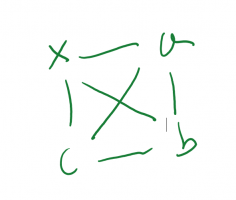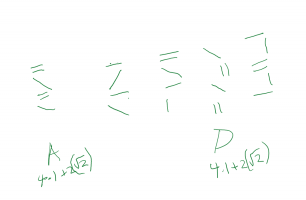eric beans
Junior Member
- Joined
- Sep 17, 2019
- Messages
- 72
Please show us what you have tried and exactly where you are stuck.I was stumped. How do you even approach this problem when you don't know what the map looks like?View attachment 28293
I think the problem makes sense only if we replace "depending on" with "regardless of".I was stumped. How do you even approach this problem when you don't know what the map looks like?View attachment 28293
I think the wording is valid, though easy to misunderstand.I think the problem makes sense only if we replace "depending on" with "regardless of".
I was stumped. How do you even approach this problem when you don't know what the map looks like?
I can't parse it. It's either depending on or independent of, no?I think the wording is valid, though easy to misunderstand.
there could be any infinite number of possible layout of the 4 towns. how was i to try them all? dejected, and clueless, what I did was i just drew a box with each of the 4 corners x, a, b, c. then i tried each of the answer choices. i didn't see any major insights. A and D traveled the longest distance and had the same distance. (i don't understand how they can predict which would be longest without a specific map of the 4 towns.) then i had the feeling i didn't understand the question and/or missed something.Please show us what you have tried and exactly where you are stuck.
Please follow the rules of posting in this forum, as enunciated at:
Please share your work/thoughts about this problem


For each of the 5 answers you need to try to come up with a map where the answer is the shortest route. You will _not_ find such a map for one of the answers. Then you'll need to formally prove that such map does not exist.there could be any infinite number of possible layout of the 4 towns. how was i to try them all? dejected, and clueless, what I did was i just drew a box with each of the 4 corners x, a, b, c. then i tried each of the answer choices. i didn't see any major insights. A and D traveled the longest distance and had the same distance. (i don't understand how they can predict which would be longest without a specific map of the 4 towns.) then i had the feeling i didn't understand the question and/or missed something.
I get the sense i missed something but i don't know what.
View attachment 28294View attachment 28295
how did you know to try AXBC?Consider choice A. Can you create a map where that route is shortest?
AXBC going left to right all on a straight line works
You do not have the map as you said. But you do not need the correct map. You need to find a situation where no map is possible.
 like this? i get distance of 6. but how does that get me to figuring out the answer?
like this? i get distance of 6. but how does that get me to figuring out the answer?how did you know to try AXBC?
View attachment 28296like this? i get distance of 6. but how does that get me to figuring out the answer?
there could be any infinite number of possible layout of the 4 towns. how was i to try them all? dejected, and clueless, what I did was i just drew a box with each of the 4 corners x, a, b, c. then i tried each of the answer choices. i didn't see any major insights. A and D traveled the longest distance and had the same distance. (i don't understand how they can predict which would be longest without a specific map of the 4 towns.) then i had the feeling i didn't understand the question and/or missed something.
I get the sense i missed something but i don't know what.
View attachment 28294View attachment 28295
Oh, I didn't understand. I thought the map of the 4 cities could be literally any infinite number of 2D arrangements. But what you're saying is it's confined to 1D arrangement along a linear line? That seems to be poor wording on the problem. I didn't get that "layout" meant automatically linear arrangement of towns.I think you may be missing what "layout" means. The points could be anywhere on your paper, not necessarily in your little square; the lengths of the edges don't have to be the same. I hope you understand that "AXBC" didn't mean going around in a square as you have drawn it, but literally laid out along a line, A----X----B----C. As you drew it, XAXBCBX is far from the shortest route; the shortest there would be (for example) XACBX. In the straight-line version, XAXBCBX is as short as you can get.
As we have said, try different layouts, hoping to make a given path the shortest. So far, we know that the first choice is not the answer, because there is a layout in which that route is as short as you can get. Yes, it takes some thought to see that. (I will tell you that my first attempts were all along a line, because that seemed like the easiest thing to try. But not all will be.)
How did you know it was linear arrangement of towns and not 2D arrangements of town? Layout as I understood seemed ambiguous.I did not know in advance. But the shortest distance between two points is a straight line. Therefore, if the shortest distance between A and B runs through X, X must lie on the line AC and lie between A and B. And if the shortest line between X and C runs through B, then B must lie on the line XC and B must lie between B and C.
i guess given 4 elements (XABC) there could be 24 different permutations/layouts. Then I'd have to try all 5 answer choices against the 24 layouts, that's like 124 possibilities. What's the trick to this? I don't think they expected to try all of them because that would take too long. I don't see what the trick is.I think you may be missing what "layout" means. The points could be anywhere on your paper, not necessarily in your little square; the lengths of the edges don't have to be the same. I hope you understand that "AXBC" didn't mean going around in a square as you have drawn it, but literally laid out along a line, A----X----B----C. As you drew it, XAXBCBX is far from the shortest route; the shortest there would be (for example) XACBX. In the straight-line version, XAXBCBX is as short as you can get.
As we have said, try different layouts, hoping to make a given path the shortest. So far, we know that the first choice is not the answer, because there is a layout in which that route is as short as you can get. Yes, it takes some thought to see that. (I will tell you that my first attempts were all along a line, because that seemed like the easiest thing to try. But not all will be.)
No, it's not correct to assume that the arrangement is automatically linear for all answers. For some answers it may have to be linear.Oh, I didn't understand. I thought the map of the 4 cities could be literally any infinite number of 2D arrangements. But what you're saying is it's confined to 1D arrangement along a linear line? That seems to be poor wording on the problem. I didn't get that "layout" meant automatically linear arrangement of towns.
If that's the case, I would need to go through XABC, AXBC, ABXC, ABCX as the four possible choices of "layout"? But still that requires me to try 20 times running through all the answer choices, no?
No, I did not say that. I said the opposite: It is not confined to any one shape, so you can't just draw one kind of picture. What I said about a linear arrangement is that that is a possibility, and often the easiest to imagine, so I started with that option.Oh, I didn't understand. I thought the map of the 4 cities could be literally any infinite number of 2D arrangements. But what you're saying is it's confined to 1D arrangement along a linear line? That seems to be poor wording on the problem. I didn't get that "layout" meant automatically linear arrangement of towns.
No, you can reason about it as JeffM said in #10.If that's the case, I would need to go through XABC, AXBC, ABXC, ABCX as the four possible choices of "layout"? But still that requires me to try 20 times running through all the answer choices, no?
Don't assume any particular distances (1 unit each, for example). And you aren't comparing between different arrangements, but within one arrangement. You want to find an arrangement for which the given route is the shortest of all routes for that arrangement that start and end at X and go through A, B, and C at least once.what i tried was to look for a layout within the choices and then try to look for the lengths. they all came out the same. so this is not the way to find the answer.
View attachment 28311
This explains why he chose A----X----B----C. Given that arrangement, for example, the route XAXBXBCBX would be longer than necessary (obviously), and there is no shorter route than XAXBCBX. On the other hand, if C were not quite on the line, then CX would be shorter than CB+BX, so that XAXBCX would be a shorter route.I did not know in advance. But the shortest distance between two points is a straight line. Therefore, if the shortest distance between A and B runs through X, X must lie on the line AC and lie between A and B. And if the shortest line between X and C runs through B, then B must lie on the line XC and B must lie between B and C.
"shortest" relative to the other 5 choices? or shortest within the choice A? If it's shortest distance within choice A, there could be infinite number of layouts in 2D space with 4 loci's to consider?Consider choice A. Can you create a map where that route is shortest?
AXBC going left to right all on a straight line works. So choice A is wrong; you can draw a map where total distance is shortest with XAXBCBX
You do not have the map as you said. But you do not need the correct map. You need to find a situation where no map is possible.
